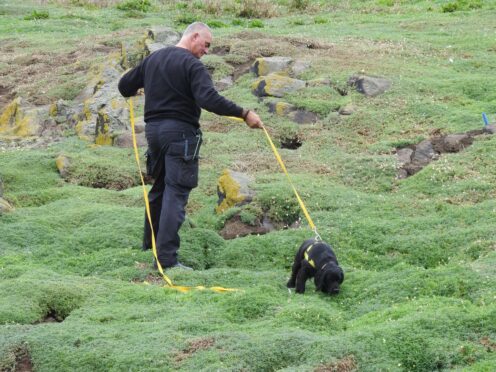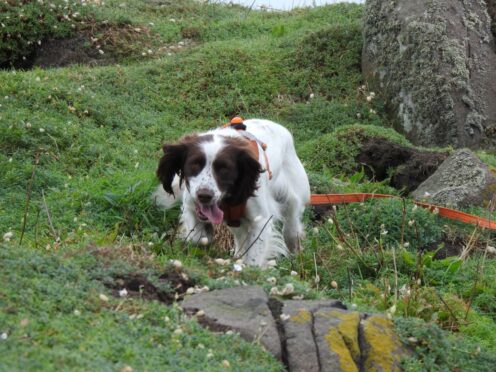Sniffer dogs have been used to locate a seabird colony for the first time in UK conservation.
Storm petrels – a small bird that spends its life at sea – were confirmed to be breeding on NatureScot’s Isle of May National Nature Reserve this past summer.
The species is notoriously difficult to monitor but thanks to help from sniffer dogs, the location and extent of the colony on the island has now been detected.
David Steel, reserve manager at the Isle of May, said: “We were really excited to work with the dogs and the dog handlers to find out more about storm petrels on the island.
“These special seabirds come ashore under the cover of darkness and nest underground in crevices, burrows, cairns or stone-walls, raising a single chick.
“During that time, their activities – singing away in total darkness, as well as their unique musky smell, make these birds so fascinating and mysterious.
“We’re delighted to confirm the storm petrel colony after such a great team effort over the last three years by so many people.”
A ‘very exciting’ discovery
Five professional sniffer dogs were trained over two months to locate the scent of storm petrels in underground burrows. The time of year the dogs got to work was crucial to ensure no other wildlife was disturbed.
The dogs each spent 20 minutes walking transects and searching for nesting storm petrels with the team marking 63 positive indications along the way.
Burrows were successfully identified which indicate where the pairs of birds are nesting on the island. Next spring, endospcopes and playback recordings of calls will be reviewed to establish their occupancy.
Simon Chapman, senior trainer at K9 Manhunt and ScentWork Scotland, worked with conservation for the first time on this project.
He said: “Having trained lots of different dogs over the years on a vast array different odours, this was a first for us to work in conservation and to locate a new colony of nesting seabirds.
“Dogs are a cost effective and fast method to cover the ground when conducting these types of surveys.”
Using sniffer dogs is ‘groundbreaking’
Mark Bolton, a principal conservation scientist for the RSPB, is the leading authority on storm petrels in the UK.
He said: “It’s very exciting to discover a new breeding colony of storm petrels in the UK, which considerably extends their known breeding range on the east coast of Britain, and increases their resilience to the many challenges our seabirds face.
“The fact that specially-trained scent dogs were used to locate many of the nesting sites is ground-breaking in the UK, and I hope it heralds a new era of greater use of scent dogs for seabird monitoring here.”
There are around 26,000 pairs of storm petrels breeding in the UK which can mainly be found on remote islands.
Their movements on the Isle of May have been tracked by volunteers from Scotland’s oldest bird observatory for many years.
By ringing the non-breeding storm petrels, they have been able to find links to much of the traditional range from the north and west of Scotland.

